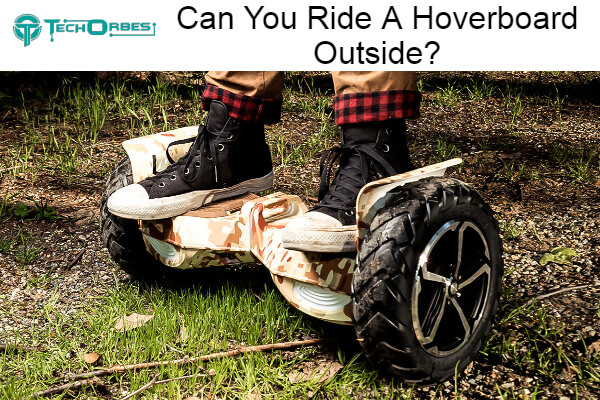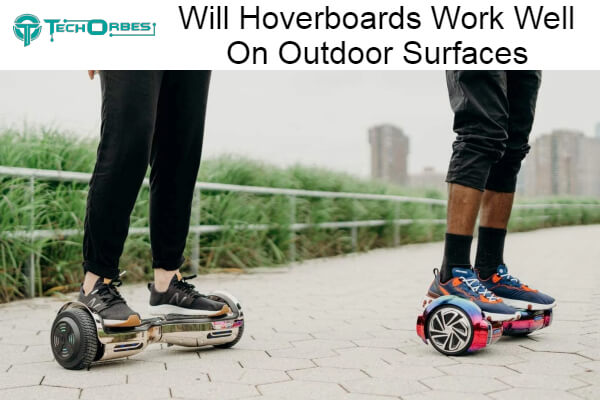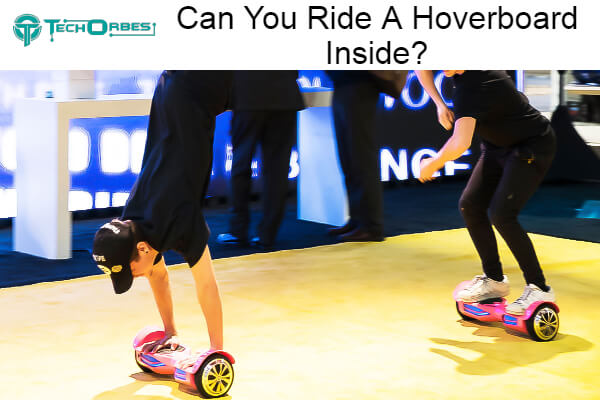Can You Ride A Hoverboard Outside? (Yes Or No)
Hoverboards are made to look like toys and be attractive, with bright LED wheels, rainbow lights, and often brightly colored plastic cases. However, they are much more durable than they look. Standard hoverboards can run fine on grass, bumpy roads, or sand. In the rest of this article, we’ll discuss Can You Ride A Hoverboard Outside? In more detail.
Can You Ride A Hoverboard Outside?
Yes, although you’ll need to check the local legislation. In the UK, it is still theoretically prohibited to use ‘powered transporters,’ such as hoverboards, in open spaces. There is still much room for interpretation as to whether or not police enforce it, regardless of how clear-cut it seems on the official.gov website.

Although hoverboards are not supposed to be used in public settings, most of us have seen kids and adults riding them on sidewalks and parks. Check out our comprehensive hoverboard legal guide if you want to get on your hoverboard and explore the world.
Will Hoverboards Work Well On Outdoor Surfaces?
For the majority of outdoor uses, an all-terrain hoverboard is not necessary. In case you were unaware, there are off-road hoverboards. Similar to the larger Segways, a more robust model is available to handle obstacles that conventional hoverboards detest, such as mud, stones, and unlevel, rocky routes. To begin with, the tires are significantly thicker.
But this could be excessive for common outside uses like walkways, highways, and even grass. You don’t need one of these boards unless you’re looking to get back to nature and engage in some serious off-road hoverboarding.

Standard hoverboards can cross uneven surfaces like grass, pavement, and roadways. However, wider cracks should be taken care of as they have been proven difficult to bridge.
Watch this video to witness a typical Jetson hoverboard used on various terrain in Nigeria, where the nation’s roads are infamously uneven and rough. As you can see, this is not an off-road hoverboard; it handles the potholes, rocks, and other roadside detritus very well.
Can You Ride A Hoverboard On Rocks?
Yes. On rocks, a hoverboard can be used. Ten suggestions are provided here for riding confidently on rocks.
- Watch out for tiny rocks that your hoverboard can now easily walk on, causing harm or even death if you’re not careful.
- Be cautious of anything pointed that could protrude through your hoverboard’s underlayer and injure you if you land on it.
- Recognize how much battery life you still have. Try to ride over smaller rocks if your hoverboard still has a good amount of energy, and keep an eye out for any that might try to poke through.
- If you weigh more than 220 pounds, don’t attempt the challenge unless you want to.
- Maintaining your footing is important since pebbles and other uneven terrain might make it more difficult for you to control your hoverboard.
- Even though riding a hoverboard over a bumpy terrain can be challenging, adding a tailwind makes it even more challenging.
- Suppose you’re going to ride on rocks; attempt to do it away from busy areas where lots of people will be looking on. Nobody likes to see you stumble and possibly get hurt.
- Bring some crash pads with you if you can do so. You can place little padding beneath the hoverboard counterweight called crash pads.
- Over a pile of rocks, do not ride. This is a bad idea since hitting a pile of rocks could cause your hoverboard to malfunction or shatter.
- Before leaving your hoverboard on rocky areas, you should always clean it. Bring your scratched-up hoverboard in for repairs so any rips or tears won’t become permanent.
- Although you’ll need to take it in for repairs, I strongly advise cleaning it to make it less intrusive. Be sure to disassemble the hoverboard and properly clean every component.
- Use a paper towel to remove any stains or dirt from the hoverboard. You can clean your hoverboard quite effectively using an upholstery cleaner. Try to avoid riding on the sandy ground since, if you do, it won’t matter what you do if you strike a rock because your wheels won’t obtain traction against it. If there is a spot of fine sand, put it on.
Safety Measures For Riding Hoverboards Outside
Yes. Hoverboards can be used outside. But take the following safety measures:
- Hoverboards should never be used in the wet.
- Be cautious when cycling on gravel or wet surfaces. Watch out for gaps in the sidewalk that people might not have cleaned up yet, avoid deep and huge puddles, and be cautious of locations with a lower curb that can provide a tripping danger.
- When riding on or next to a sidewalk or footpath, pay attention to your surroundings and the people around you. This is due to the added weight, which makes it very likely that someone will slip or trip.
- If you decide to ride in the rain, make sure your hands are constantly resting on an anti-slip mat because hoverboard wheels can get slick when wet.
- Put on the proper footwear. I advise wearing a helmet and ensuring your elbows, knees, and wrists are properly protected.
Can You Run A Hoverboard On The Road?
Yes. On the road, a hoverboard is legal to use. There are a few considerations, but it is quite legal to do so. If you’re riding at night, be mindful of other drivers and make sure your board has the proper lighting.
Although you can use your hoverboard on pavement, it is best to avoid doing so as this could endanger passersby. It’s vital to remember that not all off-road surfaces are made similarly, so please drive carefully when necessary. As long as it is not blocking the surrounding space, you are also permitted to use your hoverboard on private property and in open spaces.
Can You Run A Hoverboard On The Carpet?
Yes. You must, however, make sure that your hoverboard has rubber tires. A hoverboard’s wheels are not designed for carpets, so if you are riding one on one, it will slide around.
If this applies to you, riding outdoors on a surface that isn’t coated with snow or on a hardwood floor would be the finest option. Given their low cost, hoverboards can be used on carpets, but exercise caution and wear shoes.
Use A Hoverboard To Avoid Falls
If you’ve never ridden a hoverboard before, you might be curious about how it’s possible to avoid landing on your face when you use one. Although this is an interesting aspect of the machines, accidents may still occur if you don’t understand how to use them safely and properly.
Therefore, take your time and practice riding a hoverboard before you start doing so in public to avoid a catastrophic fall or injury.
Kick Back On A Hoverboard
If you’ve never owned one of these gadgets or even rode one, you should probably learn how to operate it cautiously and correctly. After all, the last thing you want is to get hurt badly in an accident while walking down the street.
Can You Ride A Hoverboard In The House? Or Can You Ride A Hoverboard Inside?
Yes. Hoverboards can be used indoors. You must take precautions to prevent mishaps and use common sense.
- Make sure your floors are largely flat and free of any carpets or pieces of furniture that might become tangled in the air gap of the hoverboard.
- When using the gadget on hardwood or linoleum surfaces, avoid charging it.
- Be cautious when near animals, especially cats, which might find it amusing to toy with or chew on the charger cord for your hoverboard.
- Use the hoverboard in a room with adequate space to prevent running into objects like furniture, walls, or people by accident.
- Wear shoes that won’t cause you to trip or fall if you’re riding on carpeted floors.
- When riding on the carpet, keep the throttle below half-speed; otherwise, the air gap could not be large enough to support it.
- If you ride on uneven areas, think about purchasing a hoverboard with a level-up/level-down feature.

Can You Ride Hoverboard On The Rain?
No. Because the hoverboard’s wheels won’t be able to grip the ground, riding one in the rain is not safe.
- You might accidentally fall into the water.
- Water between the contacts will cause the controller to operate less effectively.
- Wetness would also shorten the battery’s lifespan.
- You run the risk of getting wet items within the board, which would render them useless. Additionally, but not least:
- Because water can come into touch with the charger on the inside or outside of your hoverboard, you run the risk of electrocution.
- Therefore, it is best to avoid the rain if you are riding a hoverboard or any other electric vehicle. Therefore, use caution when riding your hoverboard.
Are Hoverboards For Inside Or Outside?
Depending on your type, you can use your hoverboard indoors or outdoors. Some of the most popular hoverboards are self-balancing scooters; however, electric wheeled boards are preferable for outdoor use.
The main similarities between these two varieties are the method of propulsion they employ and the footboard, with one having a wheel and a gyroscope. While both models offer certain advantages, they are identical in terms of battery life, range, and speed.
For outdoor activities, hoverboards are fantastic. They are ideal for navigating paved surfaces and tree roots. You can utilize a hoverboard on any surface if you feel at ease on one.
It can be used on grass, rocks, gravel, woodland regions, and incline and decline slopes. The greatest self-balancing scooter models are robust materials that can withstand heavy use. To ride safely on a self-balancing scooter, make sure the wheels and bearings are of the highest quality. Look for one with bigger tires for the best ride.
The more balanced and easier it will be to travel over difficult terrain, the taller the tire. Know the boundaries of your hoverboard. It can go up to 35 mph if you choose a board without sensors and a speed limiter, which is risky.
Know your limits and provide extra space if you plan to use the self-balancing scooter for outside activities. Always wear a knee, elbow, and helmet to ensure safety and enjoyment. Letting the hoverboard fully charge before use may extend the battery life and enhance the riding experience.
Is It Better To Use Hoverboards Indoors?
When severe weather is avoided and legal requirements are considered, there is no excuse not to use your hoverboard outside. The only exception is if you’ve never ridden one before and are still in the learning period; in that case, you might want to postpone going outside and practicing indoors until you get the feel of it.
Many people feel better at ease learning in a space with a carpet to soften the fall and a solid table to rely on, as we described in our tutorial on how to get on and off a hoverboard. Although practicing on grass might be as safe in case you trip.
To Sum Up
That’s everything regarding Can You Ride A Hoverboard Outside? New generations ride hoverboards. It’s a toy and a medium that minimizes pollution. You may travel and commute with it. The hoverboard has changed people’s lives one by one. This invention gave us an alternative to polluting autos.
Frequently Asked Questions
Is a hoverboard carpet safe?
Depending on the carpet’s thickness, the hoverboard may be sluggish. Adjusting your riding takes skill and patience. You’ll need to lean more slowly on carpet than on plain pavement.
What can’t a hoverboard do?
Dry or rainy, avoid uneven pavements and terrains. This can damage and injure your gadget. Buy a rough-terrain model if you wish to ride your hoverboard over uneven terrain.

Rayssa is a native American. A group of specialized individuals raised her with a passion for gaming. Here she discovered that computer games can expand your creative mind to infinite possibilities. In recent years, she has gone beyond gaming as a means of entertainment to enjoy it as a passio
